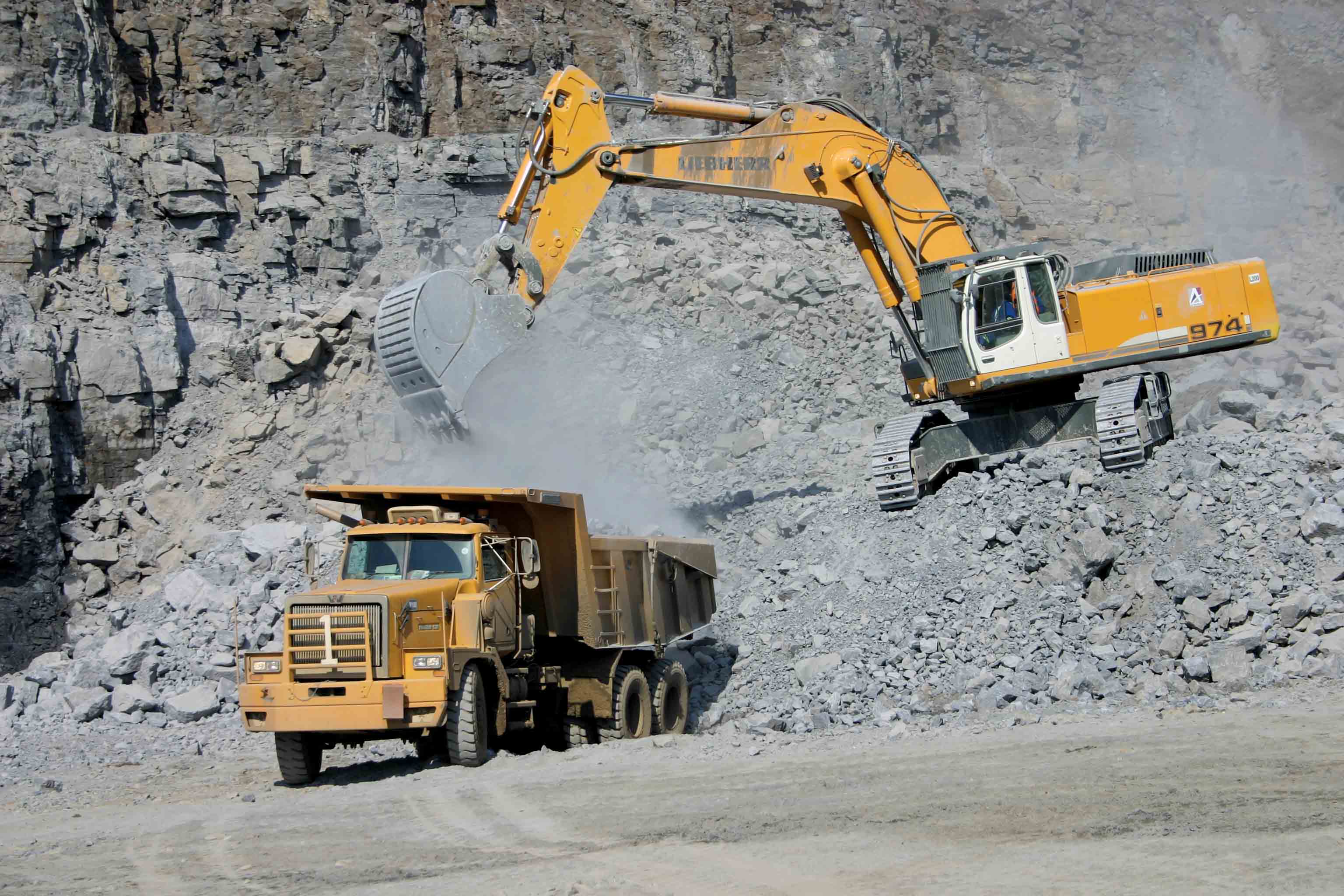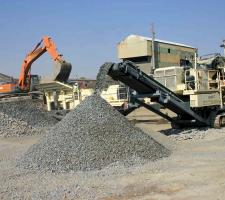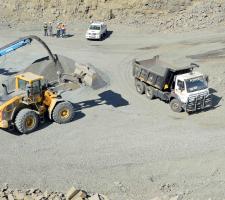
Despite difficult times in resource-extracting economies due to current downward commodity prices, Africa’s infrastructure projects continue apace, with spending no longer fixated on export-driven activities. Consequently, construction aggregate producers continue to see reasonable growth, but the same cannot be said about their OEM counterparts who report dipping sales of equipment into quarries. Munesu Shoko reports.
A general argument persists that infrastructure spending in Africa is buttressed by mineral resources due to the continent’s reliance on mineral exports. But, according to KPMG’s Construction in Africa Report, this is no longer the case. The report notes that GDP per capita levels in many African countries have soared past the critical US$1,000 level, enabling consumers to purchase more than just the basics. Urbanisation has also become an important factor for African governments to consider. To press home this point, Africa had 22 cities with more than two million inhabitants in 2010, and will have another 14 of that size by 2020.
African infrastructure development is no longer solely fixated on resources. Energy and power projects are the principal focus of construction in North Africa, with nearly 60% of project financing coming from domestic sources or development institutions on the continent. Southern Africa remains a gateway into the continent. Apart from the massive transport and energy projects under way in South Africa, the region benefits from many large real estate projects focused on retail shopping centres and mixed-use developments, mostly driven by the local private sector.
East Africa is buoyed by the relentless drive for regional integration. This has seen mammoth investments in mega construction projects related to transport, especially road and rail networks, as well as port facilities. Kenya and Ethiopia are the two regional powerhouses that come to mind as far as current investments into infrastructure are concerned.
Ethiopia’s construction sector will outgrow that of its neighbours over the next 10 years, growing at 11.6% on average, fuelled by a swell in infrastructure investments in the region, according to BMI Research International. With US$20 billion worth of projects in the pipeline, Ethiopia has double the amount of infrastructure investments compared to Nigeria. Kenya’s construction industry growth is predicted to be 9% this year and will maintain the trend over the next 10 years. Uganda and Tanzania’s construction sectors will grow at 7.3% and 9.5% year-on-year, respectively.
Nico Pienaar, director of the Aggregate and Sand Producers of Southern Africa (Aspasa), says these trends will have a positive impact on aggregate demand on the continent. He believes that, despite challenges in the mining sector, expected government infrastructure spend is set to lift the construction aggregates industry considerably above last year’s figures. Pienaar says the industry has been in steady growth phase since 2012, although growth has been somewhat slower than expected.
Satoshi Minaguchi, area sales manager, Strategic Sales, Africa Group at
South Africa remains one of the most mature markets on the continent, both in terms of its construction fraternity and aggregates supply chain. After cement (16%), the sand and aggregates sector is the largest building materials industry, accounting for more than 11% of all building materials sold by value in South Africa. By volume it is the largest, moving well over 100 million tonnes per year, compared with cement’s 14 million tonnes.
While there is a general feeling that construction expenditure in South Africa is way off the levels of the pre-2010 boom just before the FIFA World Cup, Andries van Heerden, CEO of Afrimat, one of the biggest quarry operators in the country with strong growth plans into the rest of Africa, paints a different picture altogether. He argues that construction activity in South Africa is at its best right now. “Government spending on road building and maintenance, as well as human settlements and water and sanitation, is at an all-time high,” he says. “I believe the construction industry is in a very good space. The relatively good performance by most aggregate suppliers is testament of the good times.”
For Van Heerden, the performance of aggregates is a true measure of the state of the construction market and he thinks it is at a very high point, especially for Afrimat, a diversified supplier of quarried material. “I believe construction is at a high point for us. “But, we estimate that more than 60% of Afrimat’s sales are now going to small and medium enterprises. We are not doing business with most of the big construction companies at present. At this stage, construction is more like water from a sprinkler than a bucket. It’s a different market altogether as projects are being packaged into smaller lots to allow smaller and upcoming contractors to have a piece of the pie. But, overall, projects are ongoing,” says Van Heerden.
Van Heerden has always maintained that there is massive opportunity in Africa, but Afrimat maintains a cautious approach when it comes to cross-border investments. “The problem with the quarrying business is that it is mostly project-driven,” he says. However, Afrimat has since taken the bold step and now owns a controlling share in a quarry in the northern part of Mozambique, in Pemba, and also has a few contract crushing operations in the country. “We are still on the early part of the learning curve of doing business in Africa, trying to find our path out there. But, I am taking a 10-year view where I would like to see 50% of our profits coming from markets outside South Africa.”
While aggregate suppliers enjoy sizeable growth in demand, the same cannot be said about equipment suppliers who report contracting sales volumes. With a challenging operating landscape in the mining sector, fleet owners are looking at ways of expanding the lifecycles of their equipment, allowing them to sweat the existing assets at the expense of fleet replacement programmes. To optimise the lifecycles of their equipment, overhauling of essential equipment components such as engine rebuilds, is fast becoming a norm. For example,
Meanwhile, Minaguchi says in general, when aggregate demand increases, demand for construction machinery also increases. However, the recent downward prices of crude oil, natural gas and mineral resources have caused substantial budget deficits in producing countries. “Consequently, the local governments are not able to allocate sufficient budget for necessary infrastructure projects,” says Minaguchi. “As a result, demand for construction machinery in Africa, especially crawler excavators and wheel loaders, has gone down from January to July by approximately 25% and 10% year-on-year, respectively, according to
Sandro Scherf, CEO of
IIkay Fidan, business director for Hub South (Africa) at
Despite the challenging market conditions in Africa, Fidan says Volvo CE has seen increased market share, especially driven by the Volvo L60Gz, L90Gz and L120Gz wheeled loader models. “We have been rolling out these models in Africa this year and this has helped us increase our market share,” says Fidan. “We have been investing heavily together with our dealer partners to improve aftermarket capabilities and offer our Volvo Trade Finance. These have been two key contributors to our success,” says Fidan.
Tristan du Pisanie, product marketing manager at Bell Equipment, says South Africa is facing some economic challenges and quarrying is no exception. “However, it will not be true to say that quarrying, as an industry, is in the doldrums. The supply of aggregates to the construction industry is fairly positive compared to what we see in the mining industry,” says Du Pisanie.
Meanwhile, he reports that
Looking ahead, Minaguchi believes that the long-term outlook for the demand in quarrying or heavy construction equipment in Africa remains positive. He says that in recent years the Maghreb region, especially Algeria, has led the demand for equipment on the continent. “Algeria has been promoting infrastructure projects nationwide and increasing aggregates and cement production,” argues Minaguchi. But, in the medium to long term, he has no doubt that the Economic Community of West African States will be a big growth region. “The main drivers are Ivory Coast, Ghana and, undoubtedly, Nigeria,” says Minaguchi, noting that a Deloitte report suggests that the total value of projects in Africa increased by 15% year-on-year last year to US$357 billion, and West Africa accounts for US$16 billion, an increase of 50% compared with 2014.
Scherf sees no significant change for the rest of the year. “We have seen the market growing smaller in the last two years. We only hope it picks up from here. This year will be another period of consolidating and ensuring that we continue managing the circumstances,” he says. “We are in an environment where things go up and down and up again. I think 2016 should be a lot better than last year. Last year was the toughest year in our existence. I think there will be a slight improvement this year.”












